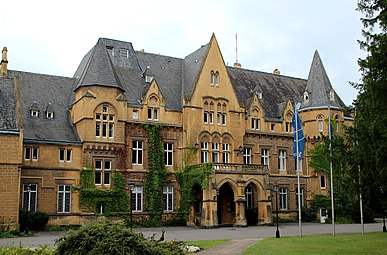
(date unknown)
Edwin Oppler (18 June 1831, in Oels – 6 September 1880, in Hanover) was a German architect of Jewish ancestry, and a major representative of the Neo-Gothic style. He designed several synagogues, throughout Germany, all of which were destroyed by rioters on Kristallnacht.
Biography
He was the second son of Saloh Oppler, a wine merchant, and his wife Minna, née Seldis. Very little is known about his childhood, except that he attended primary school in Oels from 1837 to 1840, then went to school in Breslau. In 1849, he went to Hanover, where he studied with Conrad Wilhelm Hase at the Technical University until 1854. This was followed by an apprenticeship as a carpenter.
After becoming a member of the Architekten- und Ingenieur-Verein Hannover [de] in 1856, he spent the next four years in Brussels and Paris, where he worked in the offices of Hoffmann & Massenot, with the stained glass artist, Eugène-Stanislas Oudinot [fr] and, primarily, with the architect Eugène Viollet-le-Duc. It was in the latter capacity that he became involved in the restoration of Notre Dame, and acquired his knowledge of Gothic architecture. He returned to Hanover in 1861.
In 1866, the year he was appointed a building officer, he married Ella Cohen, daughter of the Royal Physician, Hermann Cohen. They had four sons: Ernst, a painter and etcher; Alexander, a sculptor; Berthold [de], a doctor; and Siegmund [de], a jurist.
He established himself in the Jewish community through numerous commercial and residential buildings, designed for noble and bourgeois clients, but mostly through his synagogues and designs for Jewish cemeteries. From 1872 to 1878 he published a magazine, Die Kunst im Gewerbe (Commercial Art) and operated a studio together with Ferdinand Schorbach [de].
Many of his buildings were destroyed by bombing in World War II. One of his largest and most familiar, the Neue Synagoge [de] in Hanover, was burnt during the anti-Jewish riots known as "Kristallnacht", in 1938.
He died from what was apparently a rapid onset of heart disease, aged only forty-nine.
Selected projects
-
 Neue Synagoge, Breslau
Neue Synagoge, Breslau
-
 Schloss Halberg [de]
Schloss Halberg [de]
-
 Neue Synagoge, Hanover
Neue Synagoge, Hanover
-
 Haus Helsterberg [de]
Haus Helsterberg [de]
References
- Arno Herzig: Jüdische Geschichte in Deutschland. Von den Anfängen bis zur Gegenwart, C. H. Beck Verlag, 2002, ISBN 978-3-406-47637-2 and ISBN 3-406-47637-6, pg. 179; , p. PA179, at Google Books
- Peter Eilitz: "Leben und Werk des königl. Hannoverschen Baurats Edwin Oppler". In: Hannoversche Geschichtsblätter new edition, Vol.25, 1971, pgs.127–310; , p. 132, at Google Books
- Jochen Bruns: Ernst Oppler (1867-1929). Leben und Werk. LIT, Münster 1993, pp. 5, 160 ISBN 978-3-89473-406-0
Further reading
- Rudolf Bergau (1887), "Oppler, Edwin", Allgemeine Deutsche Biographie (in German), vol. 24, Leipzig: Duncker & Humblot, pp. 404–405
- Saskia Rohde: "Im Zeichen der Hannoverschen Architekturschule. Der Architekt Edwin Oppler (1831–1880) und seine schlesischen Bauten", In: Hannoversche Geschichtsblätter. New edition, Vol. 54, 2000 , pp.67–86.
- Peter Schulze: "Oppler, Edwin", In: Dirk Böttcher, Klaus Mlynek, Waldemar R. Röhrbein, Hugo Thielen (Eds.): Hannoversches Biographisches Lexikon. Von den Anfängen bis in die Gegenwart, Schlütersche, Hanover 2002, ISBN 3-87706-706-9, pg.276.
- Harold Hammer-Schenk: "Edwin Opplers Theorie des Synagogenbaus. Emanzipationsversuche durch Architektur". In: Hannoversche Geschichtsblätter. New edition, Vol. 33, 1979, pp.99–117.
External links
- Data on Edwin Oppler @ Architekten und Künstler mit direktem Bezug zu Conrad Wilhelm Hase
- Literature by and about Edwin Oppler in the German National Library catalogue